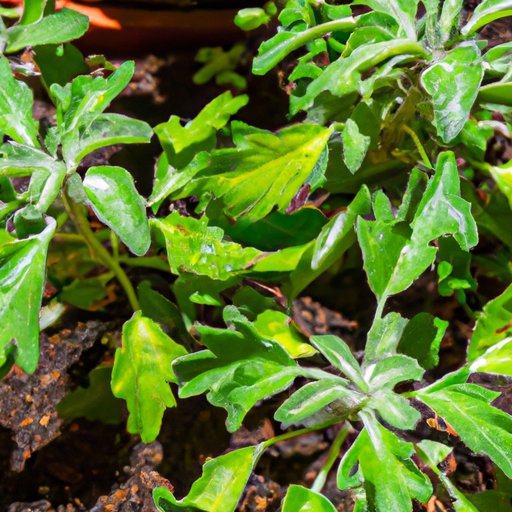Introduction
Mealybugs are small, soft-bodied insects that feed on plant sap, causing damage to plants. Although they may look harmless, an infestation can quickly get out of control and severely damage your plants. In this article, we will explore different methods for getting rid of mealybugs and preventing future infestations.
Identifying and Preventing Mealybug Infestations
One of the first steps in getting rid of mealybugs is identifying that your plants have been infested. Here are some tell-tale signs that your plants may have mealybugs:
- Small white cotton-like masses on the plant leaves
- Sticky residue on the leaves or on surfaces surrounding the plant
- Yellowing or wilting leaves
- Slow growth or stunted development
- Presence of ants around the plant
Prevention is important when it comes to mealybugs. Here are some tips to prevent infestations:
A. Proper Plant Maintenance
Mealybugs tend to infest unhealthy plants, so proper plant maintenance is essential. Provide your plants with adequate sunlight, water, and nutrients. Avoid over-fertilizing, which can attract pests.
B. Quarantine New Plants
New plants should be quarantined before adding them to your collection. Keep them separated from your other plants for a few weeks, inspecting them regularly for signs of mealybugs.
C. Inspect Regularly
Inspect your plants regularly, even if you don’t see any signs of mealybugs. Catching the infestation early is key to preventing spreading and potentially losing your plants.
D. Eliminate Ants
Ants are attracted to the sticky residue left behind by mealybugs. Eliminating ants from your plants can help prevent future infestations.
DIY Methods for Removing Mealybugs
If you detect an infestation early, you may be able to eliminate mealybugs using household items. Here are some options:
A. Rubbing Alcohol and Cotton Swabs
Dip a cotton swab in rubbing alcohol and apply it to the mealybugs. The alcohol will dehydrate and kill the insects.
B. Vinegar Spray
Mix equal parts water and white vinegar in a spray bottle. Spray the affected plant and leaves thoroughly. Repeat every few days until the infestation is gone.
C. Dish Soap Solution
Mix a few drops of dish soap with water in a spray bottle. Spray the affected plant and leaves thoroughly, making sure to coat the insects with the mixture. Rinse the plant with water after a few hours to avoid damage.
It’s important to be careful when using these methods, as some plants may be sensitive to them. Test a small area before spraying the entire plant.
Using Natural Predators to Control Mealybug Populations
Natural predators are another option for controlling mealybug populations. One of the most effective predators is ladybugs, which are known to feed on mealybugs and keep infestations under control. Here are some tips on how to encourage natural predators:
A. Ladybugs and Lacewings
Ladybugs and lacewings are natural predators of mealybugs. You can purchase them online or at a local garden store and release them around your plants.
B. How to Encourage Predators to Your Garden
Encouraging natural predators to your garden is an eco-friendly way of controlling mealybug populations. To attract ladybugs, plant flowers like daisies, fennel, and yarrow. Leaving dandelions to bloom also attracts them.

Incorporating Companion Plants to Repel Mealybugs
Companion planting involves planting certain plants alongside others to deter pests or improve growth. Planting the right companion plants can help repel mealybugs. Here are some plants to consider:
A. Marigolds
Marigolds are known to repel mealybugs. Plant them alongside your other plants, or crush the leaves and stems and sprinkle them around the infested plant.
B. Garlic
Garlic is another companion plant that can repel mealybugs. Plant them alongside or sprinkle the soil with powdered garlic.
C. Chrysanthemums
Chrysanthemums contain a natural pesticide that can help keep mealybugs at bay. Plant them near susceptible plants for a natural form of pest control.
Companion Planting Tips
Companion planting can improve plant growth and ward off pests, but it’s important to keep in mind that not all plants get along. Do some research before planting to ensure your companion plants are compatible with one another.
Chemical Treatments for Severe Mealybug Infestations
If an infestation is severe, chemical treatments may be necessary. Here are some common insecticides for mealybugs:
- Neem oil
- Insecticidal soap
- Pyrethrin
When using chemical treatments, it’s important to follow the instructions carefully and take the necessary safety precautions.
Preventing Mealybug Infestations in the Future
Preventing future infestations is essential in keeping your plants healthy. Here are some tips:
A. Plant Selection
Choose plants that are less commonly infested by mealybugs.
B. Proper Plant Spacing
Proper spacing between plants can help reduce mealybug infestations. It can also improve air circulation, which helps keep the plants healthy.
C. Inspecting Regularly
Regular inspections can help catch any infestations before they get out of hand.
Conclusion
Mealybugs can be a frustrating and damaging problem for plant owners, but there are various methods of control available. Start by identifying the signs of mealybugs and taking preventative measures. If needed, try DIY methods or encourage natural predators to your garden. Companion planting and chemical treatments may be necessary for more severe infestations. By taking these steps, you can keep your plants healthy and mealybug-free.
Remember to be patient, as some methods may take time to have an effect. Regular maintenance and inspections can help prevent future infestations.
